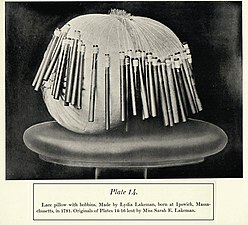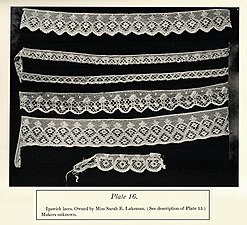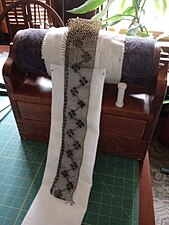Ipswich lace

Ipswich lace is a historical fashion accessory, the only known American hand-made bobbin lace to be commercially produced. Centered in the coastal town of Ipswich, Massachusetts north of Boston, a community of lacemaking arose in the 18th century. Earliest known records indicate that lace produced by local women was used to barter for goods in the 1760s, as denoted by ledger account books belonging to local merchants.[1] These laces were sold in the region from Boston to Maine.
Although some references presume that Ipswich lace represents an offshoot of the styles of British laces such as that known today as Bucks point lace, and originated with English immigration,[1][2] other evidence points to continental influence. Bucks point is theorized to have developed from Mechlin, Lille, and other lace styles brought to England with Huguenot refugees. Early Buckinghamshire region lace may be different from the characteristics of this lace in modern understanding. A key observation is that the footside of Ipswich lace sits to the left during production, contrary to English laces typically created with a footside to the right.[3]
Ipswich bobbin lace is similar to European bobbin laces of the 18th century such as Mechlin and Valenciennes, but developed characteristics and patterns of its own over the production period. They were made as borders and insertions to be added to clothing or household items. It is a continuous lace, meaning that the threads continue from the beginning to the end of the pattern, as opposed to non-continuous laces, where the threads that are used for the motifs (dense, decorative parts) are not the same threads as those used to make the fillings and grounds (the open parts connecting the motifs).[4] The motifs in Ipswich lace are mostly surrounded with a thick gimp (outline) thread. Most of the motifs are constructed with the half stitch (Cross-Twist), and the ground of small meshes connecting the motifs consists of either some variation on the Torchon ground or the Kat-stitch, also called Paris ground. A decorative edge of two-threaded picots (loops) are very common. The Point ground (cross, twist, twist, twist) as used in Bucks point and other similar laces were not used as a ground in the Ipswich laces, only as a decorative filling.
History[]
Typically the lace was produced from "prickings" or patterns created on parchment or pasteboard that were attached to a round bolster-style lace pillow. Bobbins whittled from local wood or reeds were used to provide the thread repository and the appropriate tension for constructing the lace. Linen or silk thread was the material commonly used in the early period with cotton employed only later after the development of mercerised cotton improved thread characteristics. Imported and individually handmade pins provided the structural support for the patterns, until pin-making machines became available in the 1840s. Known lace examples are largely white linen or black silk threads.
Preceding and during the American Revolutionary War, the purchase of luxury imported goods was problematic from social, political, and logistical perspectives. Hannah Adams of Medfield, who later became an eminent writer, described making bobbin lace herself during these years. The style or type of lace she made is unknown, but confirms that lace making was underway and profitable during this period in Massachusetts.
During the American revolutionary war, I learned to weave bobbin lace, which was then saleable, and much more profitable to me than spinning, sewing or knitting, which had previously been my employment. At this period I found but little time for literary pursuits. But at the termination of the American war, this resource failed, and I was again left in a destitute situation.[5]

By the 1790s, over 600 women in the Ipswich area were producing significant quantities of lace for sale. Stored in the Library of Congress with the papers of Alexander Hamilton,[6] a report of this activity was submitted to the Secretary of the Treasury with actual samples of Ipswich lace. Reverend Joseph Dana, author of the report, provided:[7]
A Return of Lace and Edging, manufactured in the Town of Ipswich, from August 1789 to August 1790. With the value of the whole, computed from the Bartering-Prices at which the different parcels of each have been sold.
Rev. Dana reported 13483 yards of edgings and 28496 yards of lace, for a total of 41979 yards of Ipswich lace made by local women in that time frame.

Lace making continued through the end of the century and into the early 1800s as a hand-made activity, and period advertisements for “American Laces” and “Ipswich Lace” indicate that the lace was available from local merchants,[8] on par with competing European laces.
Extant samples of Ipswich lace on garments can be found in various archives. For example, a mourning cap,[9] silk hood[10] and a cloak[11] featuring Ipswich lace are found in the Museum of Fine Arts, Boston. Martha Washington possessed a shawl[12] made with Ipswich lace which is preserved in the Mount Vernon collection; the lace was reportedly purchased by George Washington on his post-election tour of the young United States.[13] An additional lace segment is also at Mount Vernon.[14] Lace adorning a man's Masonic "Memento mori" apron is also an Ipswich lace.[15] A "dressed miniature" of Sarah Hamlin Sage by Mary Way (or her sister Betsy) is adorned with a shawl that appears to be a previously unknown Ipswich lace pattern.[16] The lace has characteristics of typical Ipswich motifs, and represents a non-garment based use of the lace in an art piece which is novel.[17] The Ipswich Historical Society and Ipswich Museum[18] have conserved artifacts of the lace-making activities. Historic New England displays an Ipswich pillow with bobbins and lace in progress on a pricking.
In the 1820s, attempts to mechanize lace production in Ipswich shifted activity away from hand made pillow laces to embroidery on lace bobbinet that was produced by machine.[19] Although some lace makers continued to produce pillow lace, and samples of Ipswich lace were cherished and stored by traditional lace makers like Sarah Lakeman,[20] hand-made lace making was no longer a widespread commercial practice.
In the 1970s, a lace restorer and self-taught lace maker named Michael Auclair[21] replicated the black Ispwich lace samples from the Library of Congress archives. By the 21st century, revived interest in this historical lace was supported by new scholarship and exhibition.[22] In 2001, an exhibit in The Smithsonian National Museum of American History called Within These Walls[23] displayed a historic house relocated from Ipswich[24] and included reproduction Ipswich lace and lacemaking tools. In addition, archived lace samples[25][26] that are stored in the Library of Congress have been re-created by Karen Thompson, and pattern working diagrams have been published that enable lace makers to accurately reproduce this lace today.[27]
Ipswich lace has also appeared in popular culture. A trilogy of fiction books by Brunonia Barry uses Ipswich lace as a plot device, and a major character is a maker of the lace in one of the books, The Lace Reader.[28]
Gallery[]

Samples of black silk Ipswich lace from Joseph Dana's report

Samples of black silk Ipswich lace from Joseph Dana's report

Ipswich lace pillow with bobbins

Parchment patterns for Ipswich lace, and samples of lace

Ipswich lace samples, made with white thread

Reproduction Ipswich Lace bolster pillow with a reproduced copy of a black silk Ipswich bobbin lace

Ipswich bobbin lace bobbins whittled from bamboo or wood

The ends of Ipswich bobbins show the hollow stems

Reproduction Ipswich lace made with historical pattern
References[]
- ^ a b Cotterell, Marta (1999). Benes, Peter (ed.). "Laces of Ipswich, Massachusetts: An American Industry 1750-1840". Annual Proceedings (Dublin Seminar for New England Folklife). UPNE. 22: 82–99. ISBN 1-58465-163-6. OCLC 41178040.
- ^ Powys, Marian (1953). "Lace-Making in New York State". New York History. 34 (2): 224–233. ISSN 0146-437X. JSTOR 23153315.
- ^ Miller, Marla R. "Review: The Laces of Ipswich: The Art and Economics of an Early American Industry, 1750-1840". eh.net. Economic History Association. Retrieved 2 November 2020.
- ^ Earnshaw, Pat (1984). A Dictionary of Lace (2nd ed.). Princes Risborough, Aylesbury, Bucks, UK: Shire Publications. ISBN 9780852637005.
- ^ Adams, Hannah (1832). A memoir of Miss Hannah Adams, written by herself. With additional notices, by a friend. Boston: Boston, Gray and Bowen. p. 11. hdl:2027/yale.39002004865987.
- ^ Thompson, Karen (8 May 2018). "What does Alexander Hamilton have to do with the lace industry in Ipswich, Massachusetts?". National Museum of American History. Retrieved 30 September 2020.
- ^ Dana, Joseph. "Image 23 of Alexander Hamilton Papers: General Correspondence, 1734-1804; 1791, Jan.-May". The Library of Congress. Retrieved 1 October 2020.
- ^ Pike, Richard (11 July 1797). "Impartial Herald". Newburyport MA. p. 4. Retrieved 30 September 2020.
- ^ "Woman's mourning cap". Museum of Fine Arts, Boston. 49.1003. Retrieved 2021-04-28.
- ^ "Woman's hood". collections.mfa.org. Retrieved 30 September 2020.
- ^ "Woman's hooded cloak". collections.mfa.org. Retrieved 30 September 2020.
- ^ "Lavish Lace". George Washington's Mount Vernon.
- ^ Philbrick, Nathaniel (2021). Travels with George : in search of Washington and his legacy. New York. ISBN 978-0-525-56217-7. OCLC 1237806867.
- ^ Unknown (c. 1790). "Lace trim". Mount Vernon. W-5529. Retrieved 12 March 2021.
- ^ "The North Shore Lace Industry". Scottish Rite Masonic Museum & Library. Retrieved 30 September 2020.
- ^ Ehrlich, Brian (2021-11-08). "Dressed for Success". The Magazine Antiques. Retrieved 2021-12-01.
- ^ Mangan, Mary (2022-01-01). "Finding Ipswich Lace in an Unusual Way". The Bulletin. International Organization of Lace, Inc. 42 (2): 14–15.
- ^ Ipswich Museum
- ^ Candee, Richard (1999). Benes, Peter (ed.). "Lace Schools and Lace Factories: Female Outwork in New England's Machine-Lace Industry, 1818-1838". Annual proceedings (Dublin Seminar for New England Folklife). Boston University: 100–126. OCLC 41178040. Cite journal requires
|journal=(help) - ^ Vanderpoel, Emily Noyes (1924). American Lace and Lace-Makers. New Haven: Yale University Press.
- ^ Barry, Ann (10 January 1985). "Preserving, Collecting, and Displaying Old Lace". New York Times. Retrieved 14 June 2021.
- ^ Raffel, Marta Cotterell (2003). The Laces of Ipswich: The Art and Economics of an Early American Industry, 1750-1840. Hannover: University Press of New England.
- ^ "Within These Walls". National Museum of American History. 16 March 2012. Retrieved 22 December 2020.
- ^ Kelly, John. "Perspective | This might be Washington's oldest house, but it came from New England". Washington Post. Retrieved 22 December 2020.
- ^ "Image 19 of Alexander Hamilton Papers: General Correspondence, 1734-1804; 1791, Jan.-May". Library of Congress, Washington, D.C. 20540 USA. Retrieved 30 September 2020.
- ^ "Image 21 of Alexander Hamilton Papers: General Correspondence, 1734-1804; 1791, Jan.-May". Library of Congress, Washington, D.C. 20540 USA. Retrieved 30 September 2020.
- ^ Thompson, Karen H. (25 May 2017). The Lace Samples from Ipswich, Massachusetts, 1789-1790 : History, Patterns, and Working Diagrams for 22 Lace Samples Preserved at the Library of Congress (1st ed.). [Washington, DC]. ISBN 9780999038505.
- ^ Barry, Brunonia (2009). The lace reader. New York: Harper. ISBN 978-0-06-162477-3. OCLC 433105997.
- Bobbin lace
- Lace









